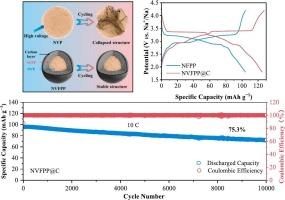Biphasic interactions between Na4Fe3(PO4)2P2O7 and Na3V2(PO4)3 to achieve ultra-long lifespan cathode material for sodium-ion batteries
IF 13.2
1区 工程技术
Q1 ENGINEERING, CHEMICAL
引用次数: 0
Abstract
Na4Fe3(PO4)2P2O7 (NFPP) is considered a promising candidate for the cathode in sodium-ion batteries (SIBs) due to its low cost and structural stability. However, it faces poor conductivity and low operating voltage. In this work, we design a step-by-step solid-state approach to heterogeneously compositing NFPP with Na3V2(PO4)3 (NVP) with outstanding electrochemical performance. The biphasic interactions between NVP and NFPP are revealed in the synthesis process and electrochemical reactions. In the core-shell structure of NFPP@NVP (NVFPP), the robust NFPP can suppress the expansion of NVP and stabilize the electrode structure, while NVP elevates the operating voltage up to 3.05 V and significantly decreases the particle size via steric effect. The carbon-coated NVFPP@C delivers a reversible capacity of 125 mAh g−1 at 0.1C, corresponding to an energy density of 382 Wh kg−1. At a high current rate of 10C, it maintains a specific capacity of 96 mAh g−1 and retains 75.3 % capacity over 10,000 cycles. This study presents a novel heterogeneous compositing strategy for designing high-performance materials for SIBs.

Na4Fe3(PO4)2P2O7与Na3V2(PO4)3双相相互作用制备超长寿命钠离子电池正极材料
Na4Fe3(PO4)2P2O7 (NFPP)由于其低成本和结构稳定性被认为是钠离子电池(sib)正极材料的一个很有前途的候选材料。但其导电性差,工作电压低。在这项工作中,我们设计了一种循序渐进的固态方法来合成具有优异电化学性能的Na3V2(PO4)3 (NVP)和NFPP。在合成过程和电化学反应中揭示了NVP和NFPP之间的双相相互作用。在核壳结构NFPP@NVP (NVFPP)中,坚固的NFPP可以抑制NVP的膨胀,稳定电极结构,而NVP通过位阻效应将工作电压提高到3.05 V,并显著减小粒径。碳涂层NVFPP@C在0.1C时提供125 mAh g−1的可逆容量,对应于382 Wh kg−1的能量密度。在10C的高电流率下,它保持96 mAh g−1的比容量,并在10,000 次循环中保持75.3 %的容量。本研究提出了一种设计高性能sib材料的新型异质复合策略。
本文章由计算机程序翻译,如有差异,请以英文原文为准。
求助全文
约1分钟内获得全文
求助全文
来源期刊

Chemical Engineering Journal
工程技术-工程:化工
CiteScore
21.70
自引率
9.30%
发文量
6781
审稿时长
2.4 months
期刊介绍:
The Chemical Engineering Journal is an international research journal that invites contributions of original and novel fundamental research. It aims to provide an international platform for presenting original fundamental research, interpretative reviews, and discussions on new developments in chemical engineering. The journal welcomes papers that describe novel theory and its practical application, as well as those that demonstrate the transfer of techniques from other disciplines. It also welcomes reports on carefully conducted experimental work that is soundly interpreted. The main focus of the journal is on original and rigorous research results that have broad significance. The Catalysis section within the Chemical Engineering Journal focuses specifically on Experimental and Theoretical studies in the fields of heterogeneous catalysis, molecular catalysis, and biocatalysis. These studies have industrial impact on various sectors such as chemicals, energy, materials, foods, healthcare, and environmental protection.
 求助内容:
求助内容: 应助结果提醒方式:
应助结果提醒方式:


